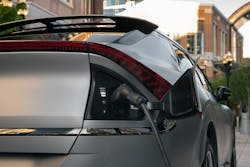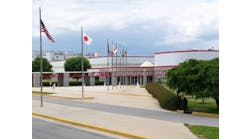When the California Air Resources Board (CARB) approved the state of California’s Advanced Clean Cars II rule on Aug. 25, 2022, the race to ban internal combustion engine (ICE) vehicles and change surface transportation for generations - at least in that state - officially began.
The phase-in period starts with the 2026 model year, where 35% of new vehicle sales in California must be plug-in hybrid (PHEV), full battery electric (BEV) or powered by hydrogen fuel cells. By the year 2030, 68% of all new vehicles sold in California must be BEVs or PHEVs.
According to the National Renewable Energy Laboratory with data from Experian Information Solutions, there were 1,454,480 vehicle registrations in 2021 classified as BEVs. California led the United States in 2021 with 38.7% of all BEV registrations, followed by Florida - in a distant second - with 6.58% and Texas at 5.56%. At the other end of the spectrum, South Dakota (0.05%), Wyoming (0.04%) and North Dakota (0.03%) had the fewest number of electric vehicle registrations last year.
To put it in perspective, Washington D.C. had more than double the number of new registered BEVs than all three of those states combined in 2021, with only 3,700 BEVs registered in the District. (The entire state of North Dakota had 380.)
The data cited only included BEV registrations and did not account for PHEVs or hybrids.
About 3% of the 250 million cars, SUVs and light-duty trucks currently on the road in the United States are fully electric. Sales of BEVs jumped 83% to almost 435,000 units in 2021. U.S. sales of hybrid vehicles jumped 76% in 2021. Regulations like the recent CARB ruling are trying to force the acceptance of zero-emission vehicles that are not powered directly by fossil fuels.
As a tire dealer, you will see more PHEVs and BEVs rolling into your shop, if you haven’t already.
In 2021, new vehicle manufacturers introduced 126 hybrid and electric models compared to just 49 models in the internal combustion engine (ICE) category. (That said, the total number of available ICE models in 2021 was still almost 4,000, while the number of hybrid, PHEV and BEV models totaled fewer than 500.)
All of the major new vehicle manufacturers are reporting increases in sales of non-ICE vehicles as the market starts to transition from a fleet of vehicles that are totally dependent on fossil fuels to one that is less reliant on gasoline and diesel.
Some manufacturers appear to be going all-in on fully electric vehicles, while others are more focused on the hybrid approach. General Motors and Ford Motor Co. are examples of companies who seem to be on the all-in path. In the meantime, Toyota, Honda and Hyundai are getting into the game with more electric models, but all of them have indicated that they are going to continue the push to introduce more hybrid vehicles as “enablers” that will lead to BEV sales as consumers get more accustomed to the new technology
Regulations like the recent one in California will definitely boost sales of BEV and PHEV models and it looks like vehicle manufacturers are banking on similar mandates in other states in the future.
Like the early days of TPMS
Hybrids, PHEVs and BEVs are here to stay and their numbers will only grow. Tire dealers need to adapt to stay ahead of this curve. In markets like California, servicing non-ICE vehicles will become a matter of survival. In other markets, tire dealerships that depend on automotive maintenance and repair for the majority of their revenue also will face increasing challenges as the national fleet electrifies.
For the past 18 years, I’ve taught tire service classes at a local community college that has a top-notch automotive technology program. High school graduates receive factory training, with the opportunity to earn their associates degree. Upon completion, they become flat-rate technicians for vehicle manufacturers. In many ways, this has given me a front row seat to observe how changes in technology impact the people who service the vehicles.
One program at the college recently got its first electric model for students to use during training. After a class, the instructors and I talked about some of the challenges that BEVs present. With decades of factory experience working on ICE models, these instructors admitted they felt out of their comfort zone working on BEVs. In some ways, they are learning with the students as they discover the differences between these types of vehicles.
In some ways, it reminded me of the early days of tire pressure monitoring systems (TPMS), which were required on new vehicles as a result of the Transportation Recall, Enhancement, Accountability and Documentation Act (TREAD) Act, which was signed into law 22 years ago this month. TPMS service was a major challenge when these systems first started showing up at tire dealerships across North America. With a national mandate looming, everyone scrambled to get the new tools and equipment needed to service vehicles with the new technology.
I remember one of the first TPMS relearn tools flew off the shelves as many tire dealers jumped in with both feet. Within a couple of years of full TPMS implementation, however, the tool had become obsolete because TPMS technology had evolved so rapidly.
As PHEVs and BEVs continue to gain popularity, there will be a growing number of tools, equipment and services made available to the automotive aftermarket. Everyone wants to get in on the ground floor of the electric revolution, but at most independent tire dealerships, there has to be a business case for spending the amount of money needed to effectively service BEVs and PHEVs.
That said, sitting on the sidelines and paying zero attention to the EV revolution may not be the best plan, especially for tire dealerships in urban areas. Right now, BEV and PHEV models work best in large cities and metropolitan areas where charging stations are easier to find and driving distances are short. Regenerative braking also plays a major role in BEV and PHEV battery life, so the stop and start of city and suburban traffic is an advantage, while long highway trips will drain batteries faster.
Tire dealerships in markets with large populations will need to be more in tune with the requirements for servicing BEVs and PHEVs because they will probably see these vehicles in larger numbers before retailers in more rural areas do.
Right to Repair
The proliferation of BEVs and PHEVs and the increasing reliance on software for repair and maintenance makes Right to Repair more important than ever. I don’t think it’s hyperbole to say that the future of the automotive aftermarket will be even more dependent on having access to vehicle manufacturer data.
The complexity of BEVs and PHEVs will give new vehicle producers ample opportunities to restrict access - forcing consumers back to their dealer networks for service.
The Tire Industry Association (TIA) and the Auto Care Association played a role in getting Right to Repair on the ballot in Massachusetts two years ago. In November 2020, voters there overwhelmingly cast ballots in favor of equal, open access to telematically transmitted automotive diagnostic and repair information.
Both associations have continued the battle in Washington, D.C. to make Right to Repair a federal law. Automobile manufacturing represents a large part of the economy and new vehicle manufacturers have a lot of influence inside the Beltway. This creates an uphill climb for the aftermarket.
Right to Repair is a great thing for consumers and a great thing for independent tire dealerships. I believe the tire industry must have Right to Repair laws on the books in every state.
Independent tire dealers should strongly support the efforts of TIA and other organizations to pass national Right to Repair legislation.
What will the future hold?
Personally, I’m still not sold BEVs and PHEVs will totally replace ICE vehicles, at least in my lifetime.
States like California will attempt to mandate the transition, but challenges like the additional power grid capacity needed to support so many vehicles will remain - at least for the time being.
I foresee rural areas having a higher concentration of ICE and hybrid vehicles because of the distances between population centers. On the other hand, large cities and many high-density suburbs are ideal for BEVs and PHEVs because charging stations are easier to locate and commutes are shorter.
I believe that if left alone, the market will organically continue to replace ICE vehicles with BEV, PHEV and hybrid models - creating a gradual transition that doesn’t upset the supply and demand model. But there are so many unknowns regarding the future of BEVs and PHEVs that it’s anyone’s guess how it plays out over the next decade.
Each independent tire dealership will have to determine if or when it gets into the BEV and PHEV game and how deep they want to play - if they want to play at all. Many tire dealerships have already found great success in the hybrid space and some are already successfully servicing fully electric vehicles.
These tire dealerships have a head start. And from a replacement tire standpoint, dealers with a strong tire program that provides access to a wide range of products will be less affected than those who don’t.
At any rate, tire dealerships that are reliant on automotive maintenance and repair must start educating their employees now and keep a watchful eye on their markets. When they determine the timing is right, they should know exactly what they need, how much it will cost and how long it will take for the investment — including technician training - to pay for itself.
It also should be noted that all modern vehicles - to some degree - are electric and that’s not going to change.
The number of electrical systems associated with ICE vehicles is going to increase as manufacturers look to improve fuel economy, lower emissions and increase connectivity for motorists.
Maintaining and repairing those vehicles will become increasingly more challenging with each new model year.
The BEV and PHEV revolution requires a much higher level of access to information and more sophisticated training, as many - including MTD’s monthly EV Intelligence columnist Craig Van Batenburg - have noted. It also will require a deeper level of investment in tools and technology.
In some markets, adapting to BEVs and PHEVs could become a matter of survival in a relatively shorter period of time for independent tire dealerships. California already has around one million BEVs on the road.
There’s no need to panic right now. We are a long way from replacing all ICE vehicles with BEVs or PHEVs. But to help ensure your company’s future success, you need to prepare for an all-electric future now.



